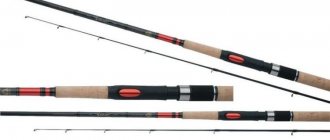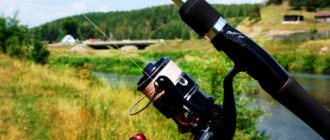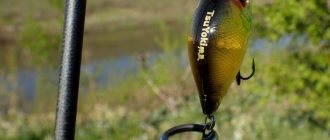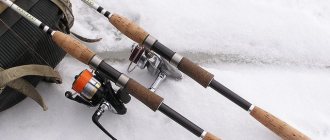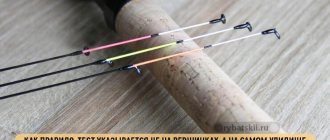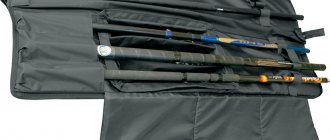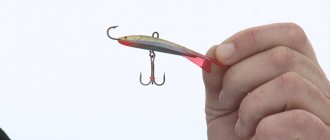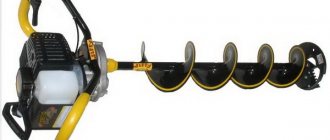Which brand of spinning rods for jig is better to choose?
The choice of spinning gear on the market is quite large; they differ in different designs, modifications, and prices. Making the right choice is not an easy task not only for beginners, but also for experienced fishermen. Original Japanese and American spinning rods are considered the highest quality, but they are also expensive. Korean and Chinese analogues are no less popular, but they undergo weaker control and their price is much cheaper. The review included manufacturers who have received a huge percentage of positive reviews and are trusted by users.
- Maximus is a Korean manufacturer, new to the fishing tackle market. The brand quickly took a leading position, as it offers a fairly high-quality assortment in the middle price segment. The main advantage is that the blanks are made of high-modulus graphite, which gives the fishing rods incredible lightness and ultra-strength.
- Salmo is a large Polish brand that produces a wide range of high-quality tackle, equipment, and accessories for fishing, tourism and recreation. All products are of our own design, made by experienced designers, technologists and designers. The brand is updated every year with seasonal catalogs for winter and summer fishing.
- Favorite is an international company specializing in the field of fishing equipment and accessories. The key to the popularity of Favorit brand products is the release of universal and multi-purpose models, both in the budget, mid-range, and premium line.
- Lucky John is a Polish brand with the size of an international company. A wide selection of fishing accessories, such as winter rods, baits, spoons, accessories for equipment and installation. This is always good quality, affordable price, reliability and unique developments. It's hard to find an angler who hasn't heard of Lucky John products.
- Daiwa is a Japanese concern with many years of experience, founded in 1945. The main type of production is the development, production, sale and repair of fishing devices, baits, equipment and accessories. The company is an internationally recognized standard of quality and the absolute leader in the sale of fishing gear on the world market.
- Mikado is a Polish brand with over 25 years of experience. Develops and produces a wide range of fishing tackle for seasonal fishing: feeder, float, jig. The products are presented in two directions: for amateurs and professionals. The main feature is testing rods and reels in close cooperation with sports fishermen.
- Shimano is a Japanese brand, one of the world's largest manufacturers of fishing equipment. The main quality criterion is the strict adaptation of goods to the sales market. The company produces products in separate catalogs for the markets of America, Europe, Australia and Japan. The brand has an official permanent representative office in Moscow.
- Aiko , a Korean manufacturer, entered the Russian market in 2007. Sales are aimed at all categories of consumers; there is a wide range of equipment, rigging and equipment for fishing to choose from. Products are divided into two lines: “Premium” and “Budget”. All products are certified and have a one-year warranty period.
- Norstream is a Russian brand from . Tackles and equipment for fishermen from Nordstream are in constant demand on the Russian market. Average price, reliability and excellent quality – these are the main components of the brand’s rating. In a short period of time, the company sold more than 40 series of spinning rods, which provided worthy competition to foreign brands.
The best jig spinning rods in terms of price-quality ratio
Norstream Kando 902MH
Rating: 4.8
One step away from the leading position is the magnificent spinning rod for jig Norstream Kando 902MH, the main advantage of which lies in the combination of weighty dough, optimal length for jigs and materials used in production. The model is made of high-modulus UTC graphite, which significantly facilitates the design and, together with the EVA pad on the handle, gives a weight of 175 grams. The length of the rod is 2.74 meters, which allows you to fish not only from a boat, but also from the shoreline, taking into account the good casting distance.
Kando 902MH is designed for bait weighing from 10 to 38 grams with a maximum line load of 4.5-9 kilograms. According to fishermen, the specimen shows its best side, but the issue of high cost inevitably wedges itself into the overall picture.
Advantages
- reliable rod design;
- presence of a cover included;
- the ability to comfortably fish both from shore and on board;
- good load capacity;
- optimal length and weight parameters;
Flaws
- high price.
Black Hole Rimer Rockfish S-802L-UL-T
Rating: 4.7

The two-section spinning rod is made of carbon and has a length of 243 cm. When folded, its size is shortened to 127 cm. The rod itself is lightweight at 106 g and does not tire the hand at all. The set includes a case for convenient transportation. The jig model is designed for light baits weighing 1-5 g. The line test is 450 g, at which it is guaranteed that the bait will not shoot off if you make a strong cast. The product has a chic handle with ergonomic cutouts and a total length of 31 cm, which provides a comfortable and secure grip. The reel seat here is made in Korea and has a long service life. In the reviews, owners are pleased with the high sensitivity of the blank and good tactile sensations in the hand when biting.
In its ultralight class, the spinning rod is notable for having one of the longest casts. This is facilitated by 9 Korea Torzite Guide SiC rings, which have a minimal coefficient of friction on the fishing line. Thanks to this feature, you will be able to catch predatory fish far from the shore and cast less often.
Advantages
- weight 106 g;
- very fast build;
- case included;
- super comfortable handle.
Flaws
- Some have a large ring installed crookedly, but this can be corrected yourself.
Rating of spinning rods for jigging
Specialists at vyborexperta.ru conducted an in-depth analysis of the market, tested more than 25 models, selecting the best nominees for the top spinning rods for jigging. First of all, the reviews of the most avid fishermen were taken into account, then the design was tested for reliability, and technical indicators were compared. When selecting for the rating, nominees were checked for compliance with the following parameters:
- Type of design;
- Number of sections;
- Rod length;
- Characteristics of the system;
- Test;
- Material of manufacture;
- Handle material;
- Weight;
- Equipment.
After a thorough study of the parameters, 10 representatives were selected to the top, who showed the best price/quality ratio. For the convenience of users, the review is divided into two groups, with a detailed description of the characteristics of each model.

The best spinning rods for trolling
The best spinning rod for microjig
Major Craft Trapara 562UL
Rating: 4.8

Trapara 562UL from Major Craft is a representative of one of the company’s budget series, designed for jig (with the prefix “micro”) trout fishing. It differs from competitors in its rather high cost, but fully justifies it during the fishing process.
An ultralight rod with a medium action is suitable for fishing fast-water rivers and streams, where the current provides additional resistance to the movement of wobblers and affects their play. Unfortunately for many fishermen, the Major Craft Trapara 562UL is designed only for small baits, the weight of which does not exceed four grams, and, accordingly, for catching small fish. However, there is also reason for joy: thanks to high efficiency, the quality of the catch can be compensated by quantity, which experienced users of this model did not fail to report.
Advantages
- combination of strength and lightness;
- reliable fittings;
- ergonomic cork handle;
- high efficiency when fishing fast-water rivers and streams;
Flaws
- high cost for a budget model;
- not suitable for fishing from the shore.
Salmo ELITE MICRO JIG 10 (2323-232)
Rating: 4.7
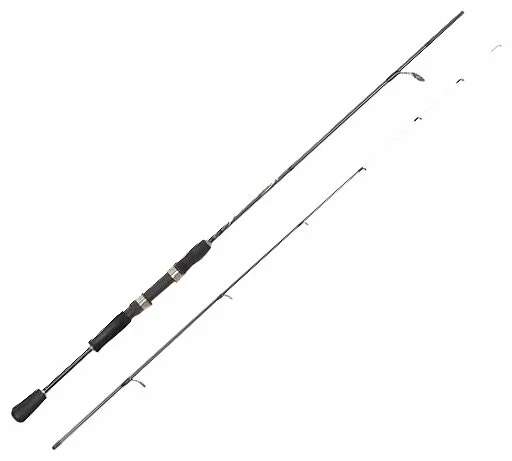
Spinning rods are perfect for catching pike, perch, chub and ide using the jig technique. The 2-10 g test allows the use of microjig gear with small baits. The total length of the rod is 2.32 m, and when disassembled it is 1.2 m. The connection of the knees via Over Steek provides increased strength. The EVA handle promotes a comfortable grip. The model weighs only 105 g and is considered ultra-light. At the same time, the carbon rod is quite durable and demonstrates amazing endurance when playing large fish.
In reviews, buyers note that the spinning rod has proven itself well for jigging on fast rivers. It perfectly holds the wobbler in a moving stream of water and helps the fisherman to distinguish by tactile sensations where the bite is and where the baits from underwater currents are.
Advantages
- works well when landing large fish;
- comfortable handle;
- the whip is very sensitive;
- durable rod.
Flaws
- for jig, the optimal weight of the bait starts only from the middle of the test;
- Some have the top rings glued in crookedly.
- (2nd place, replace Aiko Jannjeta 662ULT)
Which spinning rod for jig is better to buy?
The selection of gear for jig fishing in stores is quite large; it is a liquid and popular product. Buying a spinning rod is not difficult; it is really important to choose the right model for your individual fishing conditions. Our experts recommend paying attention to the following aspects:
- Maximus Zircon Jig MJSSZI21ML – a good choice for aggressive fishing from a boat, pronounced taper and precise sensors;
- Salmo Diamond JIG 15 210 (5501-210) – a light-duty workhorse with excellent line control;
- Favorite Jig Gun JGN -662 ML (16930185) – the loudest rigid fast action form for jig from a boat, ideal for fishing in difficult places;
- Lucky John Progress Microjig 7 LJPJ -662 LM – the best budget device for micro-jig from a boat, inexpensive and high quality;
- Daiwa Silver Creek ( SC 6102 ULFS – AD ) – good equipment with reinforced rings, will provide good fishing with any bait in the fastest currents;
- Mikado Sensei Ultrafast Spin 260 ( W – A -947 260) – medium-fast action, good power reserve for aggressive pike fishing from the shore;
- Shimano Alivio DX 240 L ( SALDX 24 L ) – build quality, durability and a good margin of safety can withstand heavy loads;
- Aiko Espada ESP 246 M (111-383) – customized spinning rod for medium-fast action fishing with maximum casting from the shore;
- Salmo Kraft SPIN L 15 7.80 ( KR 2600-240) – ultralight “fisherman” with an elastic tip, suitable for fishing fast-water rivers;
- Norstream Standard SDS 3-802 H – the best load capacity, the most powerful butt.
A thorough analysis of each model will help you not only choose a worthy assistant for jigging, but will also ensure soft step-by-step retrieving, correct guiding of the bait and a large catch under any circumstances.
Fishing with a spinning rod on a jig from the shore
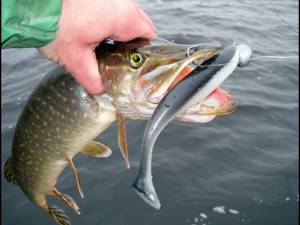
You can fish from the shore in different bodies of water - small ponds, large lakes, rivers, reservoirs, etc. If these are small bodies of water, the fishing rod should not have a long cast, and the bait may not weigh much. This means that a spinning rod for jigging and twitching from the shore will have an optimal length of 2.10 m and a test weight of up to 15 g. Although this type of fishing is not usually practiced on such reservoirs, if you have a desire to do this, it is better to select rods with ultralight test.
As for larger rivers, it is more difficult to choose a spinning rod for jigging and twitching. After all, anglers can practice both short and long casts. Since pike are usually caught on a spinning jig, it is necessary to take into account that this predator can stay far from the shore, so you need to make casts 70-100 m long, and sometimes more. It is clear that to implement this condition you need to have a long rod with the appropriate action.

As a rule, catching pike with a spinning jig is carried out with a fishing rod 2.70 m long. Of course, you can purchase a tool 3.60 m long, which allows you to cast the bait over a greater distance, but it is less convenient to use. The second reason why you should not use such spinning rods is their poor controllability. At such a distance, you need to clearly feel whether there is contact between the fish and the bait in order to hook it in time. But with such a fishing rod it is impossible to do this. Therefore, the ideal spinning rod action for jigging is medium-fast. The fishing line used is braided.
You may be interested in: Pontoon 21 GAD Harrier spinning rod
A special place is devoted to spinning for heavy jigs. It is not always easy for novice fishermen to choose. First of all, pay attention to the length. It should be about 3 meters. And the spinning rod test for this type of jig should be 80-100 g. This rod is used to catch very large predators.
Spinning test
The test is the power of the spinning rod, but this concept is quite ambiguous. The test can be based on lures in grams or ounces, as well as permissible libres of braided line. The spinning rod can be of small test, but of great power and at the same time of any formation. We select the test in grams for the bait, taking into account its weight and the weight of the load combined.
Libras are also indicated on the forms of spinning rods, for example “8–15 lb”. It is recommended to use braid in this breaking range, and the manufacturer guarantees us that when using them and critical loads on the spinning rod, the braid itself will break faster than the spinning blank will be destroyed.
However, this may often not be true. So you shouldn’t religiously believe in these inscriptions. But still, novice spinning players have to adhere to these data, at least at the initial stage. At least it’s not a landmark, but it’s a landmark. If a spinning rod has a stated bait test of, for example, 5–25 g, then the optimal performance of the spinning rod will be approximately on a scale of 10–20 g, since it often happens that the bottom of the test is slightly underestimated, and the top is too high for a more “tasty” and wide digital range . It's the same with libras. If, for example, it is recommended to install braids from 8 to 15 lb, then, as a rule, it will be optimal to use braid with a breaking load of 10–14 lb.
Spinning rod sensitivity
The sensitivity of a spinning rod is the ability of a spinning rod to transmit to you information about what is currently happening with your bait at the other end of the fishing line. For example, to distinguish touching the bottom from a bite or to understand that the bait “crosses” over a snag, as well as to determine the structure of the bottom. Sensitivity depends on many components. Here the material used to build the form, the structure itself, the test, the quality of the rings, their weight and placement, and even the reel used, everything plays a role here.
But the most important thing is the weight of the spinning rod. The smaller it is, the better the sensitivity. Now from the general to the more specific. Let's choose a spinning rod for catching pike perch. It seems that the task is simple at first glance, but some nuances make us think twice before buying this or that spinning rod. First of all, you need to clearly understand what conditions most fishing trips will take place in the future.
If you plan to fish on a river where the current is quite fast or moderate, and the bottom in such places is usually hard (sand, gravel), then the power of the spinning rod and its sensory abilities come to the fore. Spinning rods suitable for these purposes generally have a fast action, and sometimes ultrafast action. Often with such spinning rods it is quite difficult to visually track (by the tip of the whip) the step of the jig, especially in the lower 1/2 of the test range, especially if the fishing conditions leave much to be desired (side wind, big wave, etc.).
Having experience in this kind of fishing, I always take spinning rods with the expectation that I will have to fish with masses of bait, mainly 1/2 of the top declared test, which is indicated on the form of the spinning rod. This type of spinning rod is usually called “prickly”, “rapier”, and “evil” among spinners. We will conditionally call it a “non-tip” type of blank due to the weak return of the tip of the spinning rod when placing jig baits. If these are ponds, lakes, quarries, low-flow rivers, oxbow lakes, bays, reservoirs, where in most cases the bottom is heavily silted, then in such places it is more convenient to fish with whips that have a “live” tip of the spinning rod, since it is easier to track the jig step along it . Such spinning rods have the so-called. "nodding" system.
In these conditions, they are more preferable in any case, since the sensory component of the step is eaten up by the soft bottom soil, and it is much easier to track it visually, by the live tip of the spinning rod, and not by the tactile-sensory component in the hand, as I usually do on currents less end and evil spinning rods. This in no way means that the sensory of such spinning rods is worse - no, it is the same, and sometimes even better, than that of the “evil”, “rapier” rods, where the return with the end of the spinning rod is less noticeable visually when the jig touches the bottom .
It’s just that the approach and concept of constructing this spinning form are different. There is no point in finding out and arguing about what is better and what is worse, it is simply stupid, since we are all different and sometimes we have directly opposite views on the same things.
Both spinning rods are needed, they are in full demand for their fishing conditions. I am very glad that now on our market there is a huge selection of spinning rods that will satisfy the needs of any, even the most demanding spinning player. Here you just need to decide which type of form construction is closer and more convenient to you personally.
Based on the experience of communicating with colleagues, I will say this: end-action spinning rods (nodding rods) are more suitable for beginners, since with them it is easier to learn and master the basics of jig fishing. Spinning anglers, who have been fishing for more than one year, still gravitate towards spinning rods that are more “prickly”, “rapier-like”, “angry”, as they allow for much more varied placement of various baits.
This type of spinning rod, as a rule, also has a stronger restraining resource on the blank; they not only have a very powerful and hard butt, but also the middle part of the spinning rod, which bends only under a fairly strong impact on the blank. During forced fishing, such spinning rods do not bend to the very handle and do not turn off on large fish (“switching off” occurs when the upper 2/3 of the blank is straightened, as it were, in line with the fishing line).
Rigid spinning rods allow you to more clearly control the process of landing quite worthy, and sometimes trophy, specimens. It is this factor that is one of the most important for experienced spinning players, why they choose this system. Although these spinning rods have their drawbacks. This system of spinning rods does not throw the bait itself.
Here it must be dispersed with a biting and sharp cast, comparable to the click (clap) of a whip, which requires not only a more forceful approach to casting, but also professional skills to avoid shooting baits. Well, one more drawback, which we have already talked about, is that it is difficult to control the step under certain conditions. From the above we can conclude that any type of spinning rod has both its pros and cons. Accordingly, when choosing a spinning rod for your fishing conditions, you need to know and take this into account, understanding that today there is no universal spinning rod that would be equally suitable for all types of spinning fishing.
But professionals in the field of “spinning rod construction” do not stand still, offering new developments, changing the very approach to modern gear. So, recently there has been a tendency towards the fact that spinning rods have increasingly begun to appear, which have the advantages of both types of spinning rods that I listed above, and at the same time their disadvantages are minimized.
Their whip itself, for example, already has the “ultrafast” action type, which is characterized by a pronounced bend of only 1/6 of the upper part of the blank. Here we got only the very top part of the “nod” type of spinning rods. But the powerful middle part and the butt itself are from the second type of blank.
Putting this together, we get the following: the live tip provides optimal control of the bait when using various types of retrieves and its excellent visual control in any fishing conditions. This is an undeniable advantage. And also, due to the large rigid section of the blank, it becomes possible to reliably hook, hold and remove fish in the most difficult situations without losing control over it.
Considering that today such spinning rods are made from high-modulus materials, in addition to everything we get excellent tactile sensitivity in the hand due to the excellent sensory capabilities of these forms. Now let’s go through the specific models of spinning rods that are in my arsenal today. Perhaps this will help some of you decide on choosing a particular spinning rod for your tasks and conditions. And I will try to openly and honestly talk about all the pros and cons of the spinning rods that fell into my hands.
LAMIGLAS CERTIFIED PRO X86MTS and X83MTS
The CERTIFIED PRO spinning rod belongs to the “nod” type of whips. The test declared by the manufacturer is 7–17.5 g. Practice has shown that the working test of these sticks is 8–25 grams without any worries, and the braids used have a tensile strength of 8 to 15 grams, which allows you to adequately fight with trophy specimens. The Certified Pro spinning rod series itself has been produced for a very long time, more than ten years, and therefore is well known and loved by many of our spinning rods. Spinning rod blanks have a unique feature: the design of the whip is called Magnum Taper (in the articles it is indicated as MT).
There are several explanations for this name, in particular, this is the name of the shape of a “large-volume vessel with a thin neck.” We have adopted a more commonly used term - “bottleneck”. The task in constructing such forms was posed as follows: to create an ideal spinning rod for fishing with compact baits, such as oscillating spoons, and to make it possible to carry out decent and accurate casting, guiding with the current, across or against it. The spinning rod required complete control over the bait during all these manipulations, which, you see, is not easy, as well as reliable hooking and landing of fish with good and timely testing of the spinning rod in jerks.
Let us at least remember what a pike is capable of near a boat or shore, its somersaults, candles, jerks. The manufacturer will not reveal to us all the subtleties of the structure of this whip, but we don’t need it. Only one thing can be said for sure: the series was a great success, and it fulfills its tasks perfectly. In addition, it quickly became clear that such spinning rods (Magnum Taper), made of high-modulus material, are perfectly suited for fishing with jig baits in our Russian way (and it differs significantly from the American one), which was appreciated by Russian spinning anglers.
Thanks to this series, a considerable army of fans of this brand as a whole has appeared. The most popular and popular models are the X10MTS, X86MTS and X83MTS, both for fishing from a boat and from the shore. At the moment, having caught enough of the Lamiglas X86MTS, I can confidently say about it as an excellent universal stick, which is in demand not only for fishing with jig baits, but is also excellent for catching fish such as pike, asp and zander.
The whip also works well with medium-sized spinners. How many warm memories he left while catching large chub in the riffles with wobblers! And with sunset, without even changing the place of fishing or the tackle itself (but only the type of wobblers), I was already ready to catch night pike perch. It is perfect for this task as well. You don’t have to worry and be sure that the spinning rod will not let you down. When fishing for fish, the spinning rod works in such a way that the spinners say “sticks the fish,” that is, it does not give it a chance to escape.
Also, these spinning rods have proven themselves to be excellent jigging rods with a pronounced “nodding” action, without compromising the sensory component in the hand. This series is most in demand in still water or in shallow currents (reservoirs, lakes, quarries, etc.), where fishing conditions are far from ideal (wind, muddy bottom), and in such places the step requires tighter control. This is where the “nod” of the tip of the spinning rod and visual control are simply irreplaceable.
Today, fishermen, in pursuit of newfangled trends, are trying to take something new, and in their opinion, the best, and therefore put these spinning rods up for sale at half the price. For beginners, this is a good chance to buy an excellent spinning rod at minimal cost, giving the spinning rod a second life, and at the same time give yourself a lot of fishing trips with excellent equipment, the characteristics of which are not inferior to leading brands with much higher prices.
Spinning rod structure
The action is the bending of the spinning rod under load. To put it simply and briefly, there are 3 types of spinning rod action: fast, slow and medium. A fast action is one in which only the tip of the spinning rod bends. This type of spinning rod is more convenient for precise casting, sharp hooking, and they are also more sensitive to bites. In jig fishing, the most common and respected option by many. Slow action is when the spinning rod bends entirely, right from the handle. The advantages are long casting and softer fishing, since the spinning rod smoothes out the jerks of strong fish, but control over the actions of the fish itself is weakened. I think that even beginners will guess that the middle tuning is between the two previously listed.
